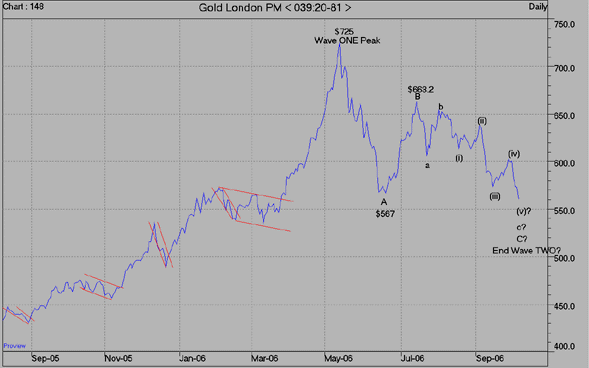|
|||||||||||||||||||||||||
Elliott Wave Gold Update IXAlf Field At the low prices on both Comex and the London PM fixings last Friday (6 October), the C wave of the correction was almost precisely 61.8% of the A wave. Equally important, the minor waves in wave C have completed a full Elliott Wave sequence. The picture can be seen most clearly in the following chart of the London PM gold fixings:  Just to run through the numbers, wave A declined from $725 to $567, a total drop of $158. Wave B rallied to $663.2. If wave C is 61.8% of the A wave decline of $158, wave C would extend for $97.6 (61.8% of $158) from the B wave peak of $663.2. This gives a target for the end of wave C of $565.4 ($663.2 - $97.6). The London PM fixing on 6 October 2006 was $560.7. On the Comex gold futures, the corresponding figures are an A wave decline of $171.3 from the May peak of $733 to the June low of $562. Taking 61.8% of the wave A decline of $171.3 produces a figure of $105.9 as the potential magnitude of the wave C decline. Wave C commenced at $674 on the Comex futures, implying a potential low of $568.1 ($674 - $105.9). The low price on the Comex
gold futures on Friday 6 October was $567.0, slightly higher
than the low on 4 October of $563.6. Both these lows are within
a few dollars of the $568.1 figure calculated above as the target
low point. While these numbers are close to the target, they
take on added importance when cognisance is taken of the fact
that the minor waves in the correction have completed an adequate
Elliott Wave corrective sequence. Analysis of minor wave c within corrective wave C:
* Forecast assuming wave (v) is the same size as (i) at - $40.5 This target of $562.5, determined by a different method involving minor wave forecasts, is also exactly in the range of lows seen in the past few days on both Comex and the London PM fixing on 6 October. The $562.5 target is exactly $1.80 from the PM fix on Friday 6 October of $560.7. It would thus not be a surprise if the 6 Oct PM fix of $560.7 was the actual low. The confluence of targets in the $560 to $568 range suggests that the gold price lows on 6 October 2006 marked the end of wave C and also the end of the first major correction (wave TWO) of this gold bull market. If this is so, we should see the gold price move rapidly upwards in a strong impulse move, starting almost immediately. The next major wave is wave THREE, the strongest of the upward waves, implying some dramatic action on the upside. Targets for the end of major wave THREE are vastly higher than the current gold price. We should wait for confirmation that we are actually in wave THREE before calculating the upside potential for this wave. What we are looking for is: 1) immediate strong upside impulsive action and, 2) a breakout from downtrend from the May peak. This will probably be evidenced by the gold price knifing upward through $610. Nothing is certain in this life. That is why questions marks are shown on the chart above at the potential lows for the various waves that appear to have terminated at the lows on 6 October. We should not forget that C waves are sometimes the same length as A waves. If this were to be the case, we would be looking at targets of $505 basis PM fixes and $502.7 basis Comex futures. If we do not see immediate strong upside action taking the gold price above $610, and we see the gold price dipping to new lows, we will need to prepare ourselves for the possibility of a decline to near the $500 mark. At this stage the odds seem to favour the analysis that the major correction, wave TWO, has been completed and that strong upside action in the gold price lies immediately ahead. 7 Oct, 2006 Disclosure and Disclaimer Statement: In the interest of full disclosure, the author advises that he is not a disinterested party in that he has personal investments gold and silver bullion, gold and silver mining shares as well as in base metal and energy companies. The author's objective in writing this article is to interest potential investors in this subject to the point where they are encouraged to conduct their own further diligent research. Neither the information nor the opinions expressed should be construed as a solicitation to buy or sell any stock, currency or commodity. Investors are recommended to obtain the advice of a qualified investment advisor before entering into any transactions. The author has neither been paid nor received any other inducement to write this article. |
